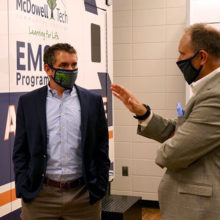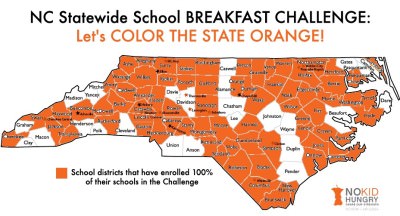
Hunger in the United States, and in North Carolina, does not look like what we expect.
The minds of many may well drift to the Depression era photos of sunken bellies in the coal mines of Kentucky, hollow cheeks on the streets of New York City, or shanties in Mississippi and Eastern North Carolina. More recently, you may think of similar images from the Sally Struthers infomercials on behalf of hungry children in developing countries around the world.
It is little wonder then that when we publicized the No Kid Hungry NC Breakfast Challenge a few weeks ago, some readers responded by saying that as they saw it the problem in our schools was not hunger but obesity.
And, yes, we do have an obesity epidemic in North Carolina. According to the UNC School of Government, North Carolina ranks 5th worst in the US for childhood obesity.
Yet one in four North Carolina children are food insecure.
This sets up what experts refer to as the “hunger-obesity paradox.”
According to the Robert Wood Johnson Foundation, nine of the top 10 states with the highest rate of obesity are in the Southern United States, and the same is equally true for the states with the highest rate of poverty.
How could this happen? One might assume that poverty precludes you from having enough food to be obese. And, yes, being impoverished does often preclude you from having enough food, but it particularly precludes you from having enough of the right kinds of food.
Several years ago the University of Washington conducted a groundbreaking study where they compared the costs of calorie intake of both “junk food” and healthy food.
As the New York Times describes it, “Food that would be considered energy dense (and this often means “junk” food such as baked goods, snacks, and more) cost on average $1.76 per 1,000 calories, compared with $18.16 per 1,000 calories for more nutritious food such as vegetables, fruits, and more. The survey also showed that low-calorie foods were more likely to increase in price, surging 19.5 percent over the two-year study period. High-calorie foods remained a relative bargain, dropping in price by 1.8 percent.”
Many of the factors that lead to obesity are shared by those in poverty:
a lack of resources, stress, and too little physical activity.
And it isn’t just lack of access to food that confronts those in poverty, it is lack of access to healthy food. And, to add to the complexity of the issue, it isn’t even just access, it is also food education that is needed to combat hunger and obesity as a study released in February showed. Purely solving access does not lead to a decline in obesity or health-related issues.
The truth about public policy is that it is rarely cut and dry. We must confront obesity and at the same time combat hunger. We must increase access and at the same time improve food education. None of these issues will be solved in a silo. They must instead be approached systematically if we are to achieve solutions to our most pressing problems in North Carolina and beyond.
At the core of addressing these issues, I believe is empathy. We must begin to understand, and have compassion, for the reality facing our neighbors. As Farad Ali, of the N.C. Institute of Minority Economic Development, recently told a gathering that I attended, “Power is perception and perception is power. We all come from different places. We are tourists in one another’s life. People are servants to their perceptions.”
We are tourists in each other’s lives. It is the most that we can be. Educators can’t account for what happens outside of the classroom. Childhood nutrition directors can serve healthy food, but they can’t take it to the houses of the students for every meal. A child can be both hungry and obese. We can perceive the situation as we wish, but we do not have to be a servant to our perceptions, as Ali went on to talk about.
Instead we should strive to challenge our own perceptions, review our values, dedicate ourselves to being more empathetic, and resolve to understand that all policy decisions are complex, multi-layered, and require more than a bumper sticker answer.
Every child in North Carolina deserves the opportunity to succeed.
As Ali concluded, we are judged by how we take care of the least of these. And who are the “least of these?” Let’s begin with the 27 percent of children who are food insecure and go from there.


